
Hawarden is a village and community in Flintshire, Wales. It is part of the Deeside conurbation on the Wales-England border and is home to Hawarden Castle. In the 2011 census the ward of the same name had a population of 1,887, whereas the community of the same name, which also includes Ewloe Mancot and Aston had a population of 13,920. The scenic wooded Hawarden Park abuts the clustered settlement in the south. Hawarden Bridge consists of distribution and industrial business premises beyond Shotton/Queensferry and the Dee. The west of the main street is called The Highway, its start marked by the crossroads with a fountain in the middle, near which are public houses, some with restaurants.
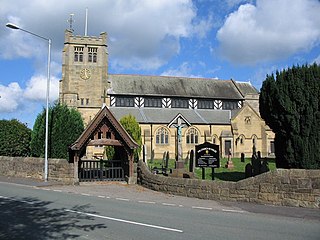
Buckley is a town and community in Flintshire, north-east Wales, two miles (3 km) from the county town of Mold and contiguous with the villages of Ewloe, Alltami and Mynydd Isa. It is on the A549 road, with the larger A55 road passing nearby.

Alyn and Deeside was one of six local government districts in the county of Clwyd, north-east Wales from 1974 to 1996. There is still a parliamentary constituency of the same name.

The Buckley Railway was opened from Buckley to a connection with the Chester to Holyhead main line on 7 June 1862, to convey coal and finished brickworks products from the Buckley area. Numerous short tramroads had existed in the area from the 1700s. The line was steeply graded and sharply curved.

All Saints' Church stands in the former coal mining village of Gresford in Wrexham County Borough, Wales. It is a large, mainly late 15th-century church in a slightly red sandstone, in many ways more typical of nearby Cheshire churches. It has been described as the finest parish church in Wales, and has the most surviving medieval stained glass of any Welsh church.

Gladstone's Library, known until 2010 as St Deiniol's Library, is a residential library in Hawarden, Flintshire, Wales, UK.

St Giles' Parish Church is the parish church of Wrexham, Wales. The church is recognised as one of the finest examples of ecclesiastical architecture in Wales and is a Grade I listed building, described by Sir Simon Jenkins as 'the glory of the Marches' and by W. D. Caröe as a “glorious masterpiece.”
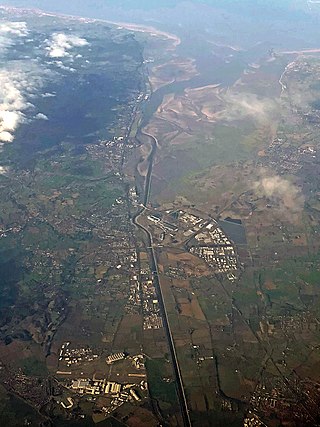
Deeside is the name given to a predominantly industrial conurbation of towns and villages in Flintshire and Cheshire on the Wales–England border lying near the canalised stretch of the River Dee that flows from neighbouring Chester into the Dee Estuary. These include Connah's Quay, Shotton, Queensferry, Aston, Garden City, Sealand, Broughton, Bretton, Hawarden, Ewloe, Mancot, Pentre, Saltney and Sandycroft. The population is around 50,000, with a plurality (17,500) living in Connah's Quay.

Erbistock is a village and community in Wrexham County Borough, Wales. The village lies on the banks of the River Dee.
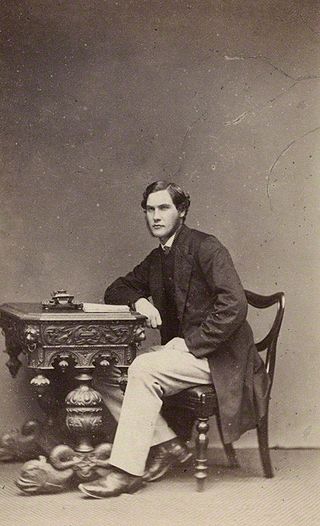
William Henry Gladstone was a British Liberal Party Member of Parliament, and the eldest son of Prime Minister William Ewart Gladstone and his wife Catherine née Glynne.

(New) Hawarden Castle is a house in Hawarden, Flintshire, Wales. It was the estate of the former British prime minister William Gladstone, having previously belonged to the family of his wife, Catherine Glynne. Built in the mid-18th century, it was later enlarged and externally remodelled in the Gothic taste.

Stansty is an area and electoral ward in Wrexham County Borough, Wales, lying to the immediate north-west of the city of Wrexham. It is a former civil parish and township. Stansty is also an electoral ward to Wrexham County Borough Council. The ward population as taken at the 2011 Census was 2,114.
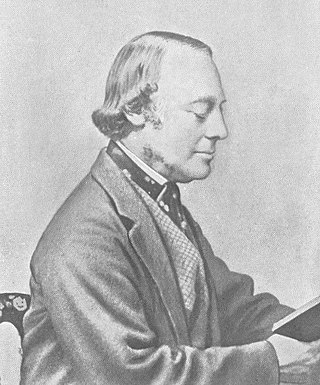
Sir Stephen Richard Glynne, 9th Baronet was a Welsh landowner and Conservative Party politician. He is principally remembered as an assiduous antiquary and student of British church architecture. He was a brother-in-law of the Liberal Prime Minister William Ewart Gladstone.

Bretton is a village in Flintshire, Wales. It is located to the west of the city of Chester, near the border with Cheshire, England. Along with the nearby village of Broughton, the population was 5,791 at the 2001 Census.

Marchwiel is a village and community in Wrexham County Borough, Wales.

St Deiniol's Church, Hawarden, is in the village of Hawarden, Flintshire, Wales. It is the parish church of the rectorial benefice of Hawarden in the deanery of Hawarden, the archdeaconry of Wrexham, and the diocese of St Asaph. The church has associations with W. E. Gladstone and his family, and is designated by Cadw as a Grade II* listed building.

St Matthew's Church, is in the town of Buckley, Flintshire, Wales. It is an active Anglican parish church in the Borderlands Mission Area, the archdeaconry of Wrexham and the diocese of St Asaph. The church is a Grade II* listed building.
Horace Mayhew of Broughton Hall, Flintshire, was a British mining engineer and colliery owner who founded the town of Broughton, Nova Scotia, now one of Canada's most famous ghost towns. He was the son of John Mayhew Esq of Platt Bridge House, Co. Lancaster, and Elizabeth Mayhew, JP Lancashire (1876), JP Flintshire (1888), Deputy Lieutenant (1900), and High Sheriff of Flintshire (1904).

The Garrison Church is a heritage-listed active Anglican church building located at Argyle Street in the inner city Sydney on the edge of the suburb of Millers Point in the City of Sydney local government area of New South Wales, Australia. It was designed by Henry Ginn, Edmund Blacket and built from 1840 to 1846 by Edward Flood and George Patton. It is also known as Holy Trinity Anglican Church and Hall. The property is owned by Anglican Church Property Trust and was added to the New South Wales State Heritage Register on 2 April 1999.
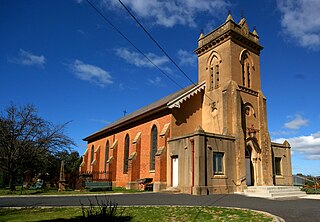
Holy Trinity Anglican Church is a heritage-listed Anglican church precinct, containing the church, rectory and adjacent cemetery, at 71-85 Gilmour Street, Kelso, Bathurst Region, New South Wales, Australia. The church was built from 1833 to 1878, with John Foster being responsible for the building of the original church. Edmund Blacket designed the rectory. The property is owned by Anglican Property Trust Diocese of Bathurst and Parish of Kelso, Anglican Diocese of Bathurst. It was added to the New South Wales State Heritage Register on 14 January 2011.


















